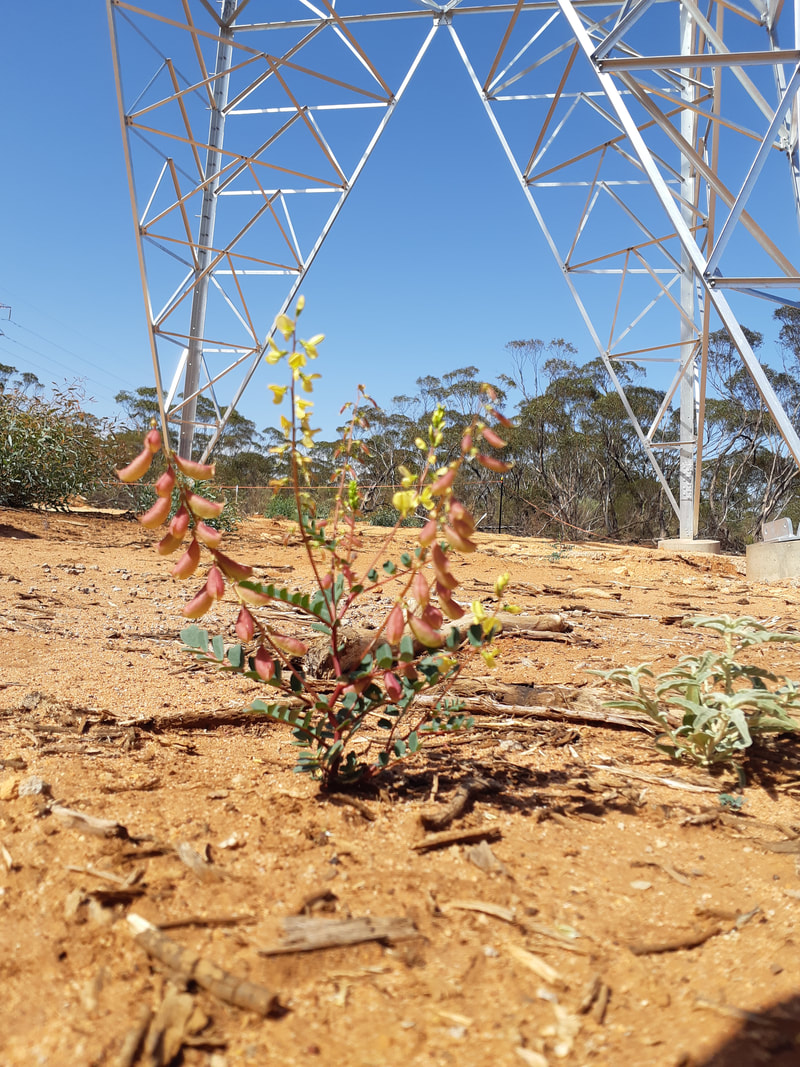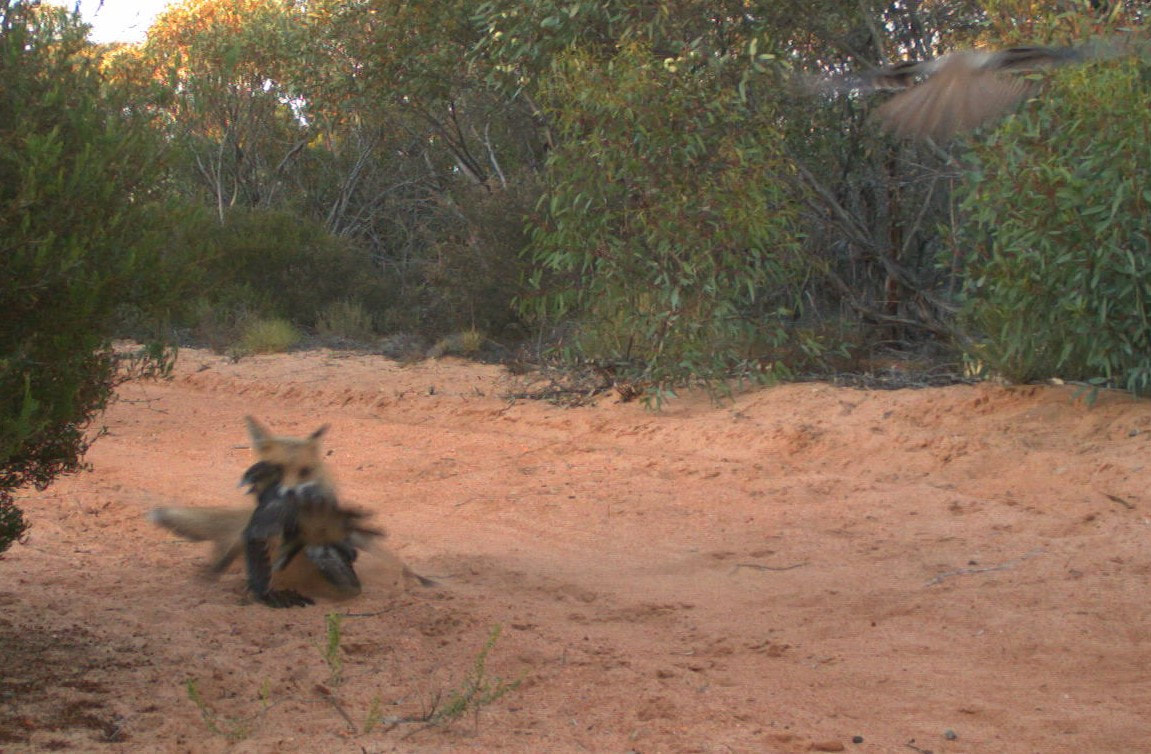 WUPPA CHUPPA CHUPPA CHUPPA The unmistakable sound of a helicopter banking through the scrub cut through our dawn chorus of white-fronted honeyeaters, scrub robins and crested bellbirds. I scanned the horizon searching the row of shiny new pylons that emerged, offensively, from patches of low-lying fog. But the chopper stringing the new Eyre Peninsula High Voltage transmission line was hidden. To Mecanno enthusiasts and power infrastructure nerds, the towering beacons represented ‘Stairways to Heaven’. But for us as landholders, these taller, shinier pylons were aesthetic and environmental insults, reminiscent of Joni Mitchell’s song about how we ‘Paved Paradise to Put up a Parking Lot’. NIMBY Katherine and I were aware of the ecological risks of carving corridors through native vegetation. We’d seen horehound and onion weed spread along the original powerline and were concerned about buffel grass establishing and irreversibly changing the mallee. I’d followed fox and feral cat tracks along the corridor and even seen one of these foxes kill an endangered Peregrine falcon chick. Trespassers using the powerline access track had shot a wedge-tailed eagle and a malleefowl. Our best fruiting quandong tree had been mulched to smithereens when Electranet’s contactors removed ‘encroaching regrowth’. Like most people passionate about their property or cultural or environmental jewels, we opposed the new powerline traversing our patch. “NIMBY” (Not In My Back Yard!), we declared valiantly but unsuccessfully. The economics of re-routing the powerline along the cleared Lincoln Highway or edges of farming land instead of ripping another line through one of the last strongholds of the nationally threatened sandhill dunnart, malleefowl and chalky wattle didn’t stack up. Not all bad WUPPA CHUPPA CHUPPA CHUPPA. Surprisingly though, I was actually pleased to hear the chopper, one of the very rare anthropogenic noises audible at Secret Rocks. Through using the chopper-stringing technique, Electranet had avoided clearing a new line. Instead they built short spur lines from the existing powerline track to their new megapylons. A couple of weeks ago their environmental staff had taken me to inspect their stringing plans and proposed rehabilitation work. Gangs of High Vis workers in cranes and trucks dutifully pulled over into demarcated passing areas as we passed. Other areas defined by bunting prevented potential damage to environmental or cultural sites. As expected, Electranet had also thoroughly surveyed the powerline corridor for important sites and had arranged offsets for unavoidable damage to vegetation or threatened species habitat. I’d also been impressed with how their principal contractor, Downers, had arranged the prefabricated pylon segments on the carefully demarcated pads like a Tetris, keeping disturbance to a minimum. But just because they were doing a good job minimising their impacts didn’t mean that Electranet deserves an environmental award, yet. Bunnies or bilbies? Twenty years ago, whilst working as an ecologist at Roxby, I had been encouraged to answer a provocative question “Are miners the bunnies or bilbies of the rangelands?” Before myxo and then calicivirus decimated their numbers, rabbits were environmental enemy #1 in Australian deserts. By contrast the rare bilby, was a conservation icon and an important ‘ecosystem engineer’ that helped the environment. However, in some important ways rabbits had replaced the digging role that bettongs and bandicoots once played. Likewise, the powerline track created firebreaks, breaking up the country and helping to reduce large scale wildfires. This is something that the Barngala used to do more efficiently and expertly to refresh the country using patch burning. Several important ‘islands’ of unburnt scrub were saved by the powerline track during our Christmas 2019 fires. Ironically one of the rare plants Electranet was required to survey for actually benefited from the powerline. Swainsona pyrophilla means ‘fire loving’ but it also loves bulldozers. Although not found on the preconstruction surveys, several plants flowered spectacularly on the pylon pads after the big January rains and their seeds will sit dormant for decades until the next fire or bulldozer stimulates germination. Just as an underground mine was not the main threat to the desert environment around Roxby, the powerline construction alone is unlikely to be in the top ten threats to mallee animals or plants. Unnaturally large and severe fires, too many feral or native herbivores, weeds, invasive foxes and cats, climate change and possibly chemical spray drift from neighbouring farms may all represent greater long-term threats than a sensitively-constructed powerline. Strive for Positives Whilst the expectation and requirements on developers is to minimise their disturbance, they have an opportunity to leave a positive legacy by helping to address more significant threats. Two decades ago I argued (at that time) that Western Mining acted like bilbies by leaving a net positive environmental legacy through their control of regional pests and supporting research that benefited the environment well beyond their minesite. Electranet could have, and still might, plant other disturbance-liking rare plants under their pylons. They could take advantage of their resources to leave other positive legacies. ‘Bean counters’ with short-term budgetary concerns may protest at slightly more expenses, but visionary leadership will reap rewards and maybe awards. Our transition to renewable energy will require more powerlines. Some will traverse wild and beautiful places with endangered plants and animals. Again the NIMBY cry will be heard. But would-be opponents will be far less vociferous and demanding of companies with a track record of exceeding compliance and delivering benefits to regional environments and cultures. The challenge of electricity producers, distributors and retailers is to convince us how ‘green’ their power really is.
1 Comment
Scott
1/8/2022 05:06:05 pm
Developers need to have a change of mind set and strive to provide a Net-positive-impact to the environment if they are proposing to create a disturbance. This can be through research, funding or more importantly on-ground change. There are currrent 'offsets' for developments when they have negative impacts on the environment but sadly these rarely go far enough. Imagine if there was a $$-value put on each m2 of native habtiat being cleared - I am confident that the area cleared would be reduced and the outcomes for the environment improved.
Reply
Leave a Reply. |
Details
John L. Read, PhD, author-ecologistWakefield Press, Dear Grandpa, Why? Reflections From Kokoda to Hiroshima Archives
March 2023
Categories |

 RSS Feed
RSS Feed
